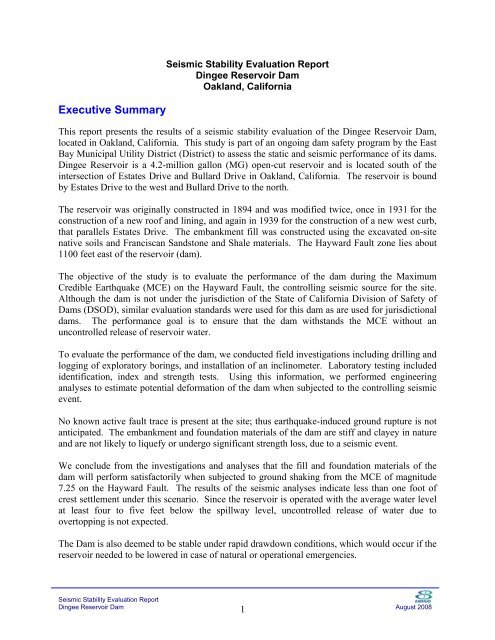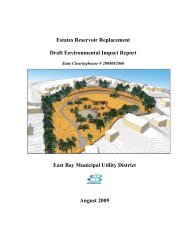Dingee Reservoir Final Seismic Report - East Bay Municipal Utility ...
Dingee Reservoir Final Seismic Report - East Bay Municipal Utility ...
Dingee Reservoir Final Seismic Report - East Bay Municipal Utility ...
- No tags were found...
Create successful ePaper yourself
Turn your PDF publications into a flip-book with our unique Google optimized e-Paper software.
Executive Summary<br />
<strong>Seismic</strong> Stability Evaluation <strong>Report</strong><br />
<strong>Dingee</strong> <strong>Reservoir</strong> Dam<br />
Oakland, California<br />
This report presents the results of a seismic stability evaluation of the <strong>Dingee</strong> <strong>Reservoir</strong> Dam,<br />
located in Oakland, California. This study is part of an ongoing dam safety program by the <strong>East</strong><br />
<strong>Bay</strong> <strong>Municipal</strong> <strong>Utility</strong> District (District) to assess the static and seismic performance of its dams.<br />
<strong>Dingee</strong> <strong>Reservoir</strong> is a 4.2-million gallon (MG) open-cut reservoir and is located south of the<br />
intersection of Estates Drive and Bullard Drive in Oakland, California. The reservoir is bound<br />
by Estates Drive to the west and Bullard Drive to the north.<br />
The reservoir was originally constructed in 1894 and was modified twice, once in 1931 for the<br />
construction of a new roof and lining, and again in 1939 for the construction of a new west curb,<br />
that parallels Estates Drive. The embankment fill was constructed using the excavated on-site<br />
native soils and Franciscan Sandstone and Shale materials. The Hayward Fault zone lies about<br />
1100 feet east of the reservoir (dam).<br />
The objective of the study is to evaluate the performance of the dam during the Maximum<br />
Credible Earthquake (MCE) on the Hayward Fault, the controlling seismic source for the site.<br />
Although the dam is not under the jurisdiction of the State of California Division of Safety of<br />
Dams (DSOD), similar evaluation standards were used for this dam as are used for jurisdictional<br />
dams. The performance goal is to ensure that the dam withstands the MCE without an<br />
uncontrolled release of reservoir water.<br />
To evaluate the performance of the dam, we conducted field investigations including drilling and<br />
logging of exploratory borings, and installation of an inclinometer. Laboratory testing included<br />
identification, index and strength tests. Using this information, we performed engineering<br />
analyses to estimate potential deformation of the dam when subjected to the controlling seismic<br />
event.<br />
No known active fault trace is present at the site; thus earthquake-induced ground rupture is not<br />
anticipated. The embankment and foundation materials of the dam are stiff and clayey in nature<br />
and are not likely to liquefy or undergo significant strength loss, due to a seismic event.<br />
We conclude from the investigations and analyses that the fill and foundation materials of the<br />
dam will perform satisfactorily when subjected to ground shaking from the MCE of magnitude<br />
7.25 on the Hayward Fault. The results of the seismic analyses indicate less than one foot of<br />
crest settlement under this scenario. Since the reservoir is operated with the average water level<br />
at least four to five feet below the spillway level, uncontrolled release of water due to<br />
overtopping is not expected.<br />
The Dam is also deemed to be stable under rapid drawdown conditions, which would occur if the<br />
reservoir needed to be lowered in case of natural or operational emergencies.<br />
<strong>Seismic</strong> Stability Evaluation <strong>Report</strong><br />
<strong>Dingee</strong> <strong>Reservoir</strong> Dam<br />
1<br />
August 2008

















